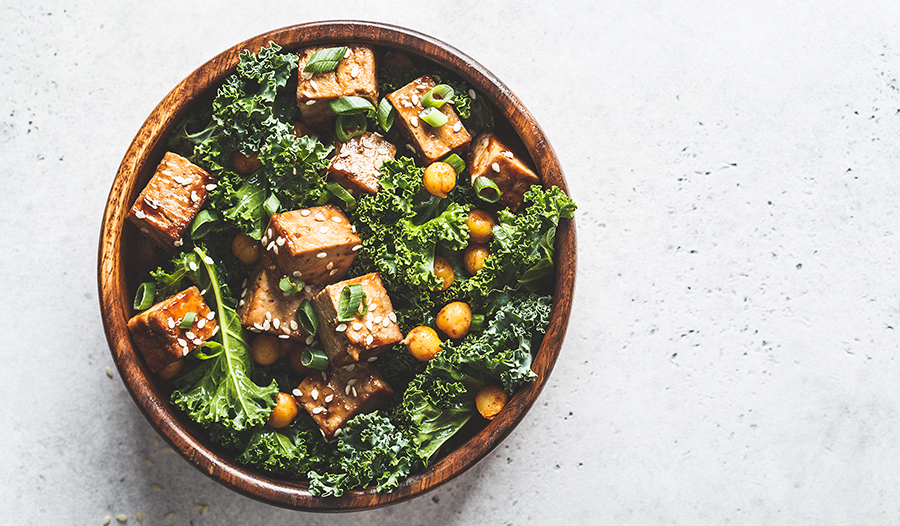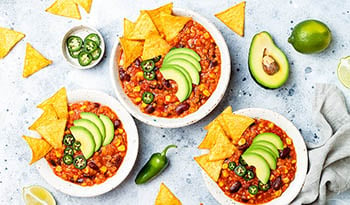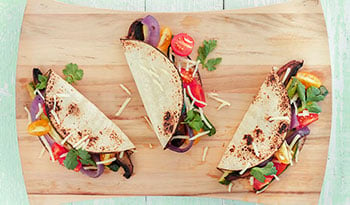How to Eat Your Daily Protein as a Vegetarian
DISCLAIMER:This blog does not intend to provide diagnosis...
- In this article:
- 4 Types of Vegetarians
- Why Is Protein Important?
- How Much Protein Do I Need?
- What Are Some Vegetarian Sources of Protein?
- High Protein Full-Day of Eating for Vegetarians
- Health Benefits of Eating More Vegetarian Proteins
- Environmental Benefit of Choosing Plant-Based Proteins
- 5 Tips for New Vegetarians

The first question people usually ask a vegetarian or vegan is “Where do you get your protein?” It’s a common misconception that protein can only come from meat. Although meat is high in protein, it shouldn’t overshadow its plant protein counterparts.
Eating a meat-free diet doesn’t mean you won’t reach your daily recommended amount of protein. Legumes, nuts, and seeds are all great meat-free protein sources that ensure adequate intake in adults following vegetarian and vegan diets.
4 Types of Vegetarians
There are many different types of diets that exclude meat. Below are the most common meat-free diets.
- Lacto-ovo-vegetarian is the most common type of vegetarian and is typically understood as simply vegetarianism. This eating pattern avoids beef, pork, poultry, fish, shellfish, or animal flesh of any kind, but includes eggs and dairy products. The word “lacto” comes from the Latin for milk and “ovo” means egg.
- Lacto-vegetarian diets avoid meat, fish, poultry, and eggs, but include dairy products like milk and cheese.
- Ovo-vegetarian diets avoid meat, poultry, seafood, and dairy products, but include eggs.
- A vegan diet excludes all animal products, including meat, dairy, eggs, and honey.
Why Is Protein Important?
Proteins are made up of amino acids and are an important part of all your cells. The body uses protein to build and repair tissues. It is also responsible for building bones, muscles, cartilage, skin, and blood. Proteins are used to make enzymes and hormones in the body as well.
When lacking the appropriate amount of protein for an extended period of time, you may be at risk of missing out on these key functions. It’s also important to note that protein deficiency is pretty rare, and it’s easy to get all the protein you need without eating meat.
How Much Protein Do I Need?
The DRI (Dietary Reference Intake) for protein is 0.8 grams of protein per kilogram of body weight or 0.36 grams per pound. For example, if you weigh 150lbs, you need roughly 54g grams of protein each day. Or you could aim to have 10-15% of your daily caloric intake come from proteins.
The amount you need each day also depends on your age, sex, and level of physical activity. Any of those factors can increase your daily protein needs. It’s best to work with a Registered Dietitian if adequate protein intake is a concern of yours.
What Are Some Vegetarian Sources of Protein?
Vegetarian proteins can include but aren’t limited to all beans: kidney beans, pinto beans, black beans, chickpeas, split peas, lentils, and soy. These foods are excellent sources of plant protein, and also provide other nutrients like iron and zinc. They are similar to animal proteins and can be considered part of the protein or vegetable food group according to the USDA (United States Department of Agriculture). For meat-eaters, beans and legumes are considered to be vegetable sources because of their dietary fiber, folate, and potassium.
Most vegetarian proteins, excluding soy and quinoa, aren’t complete proteins. This means they only have some of the nine essential amino acids. Not to worry; incomplete proteins can be combined together throughout the day to get all your necessary nutrients.
Examples of Vegetarian Protein
- Seitan is the most protein-dense of all vegetarian proteins. It is made from gluten, the main protein in wheat. It has roughly 25 grams of protein per 3.5 ounces (100 grams), which makes it the most protein-dense of all vegetarian proteins.) Seitan is one of the more popular mock meats to use due to its close resemblance to meat in texture and look.
- Mung beans are hard to find in-store but easy to order online. These legumes are underrated but have 14 grams of protein in one cup of cooked beans. Mung beans are typically eaten in salads, soups, and stir-fry.
- Tofu, tempeh, and edamame are all examples of a complete vegetarian protein. Tofu is made by pressing soybeans together in a similar way to making cheese. Tempeh is made from fermented soybeans that are pressed together. Each of these has roughly 10-19 grams of protein per 3.5 ounces (100 grams). Tofu and tempeh are popular to cook with as they absorb the flavors of other foods very well. When preparing tofu, be sure to press the water out first; boil or steam tempeh first for a less bitter taste.
- Lentils come in many varieties, but green and red are the most popular options. Not only are they popular, but they are easy to cook. Simply add lentils to water and boil until soft. One cup of cooked lentils provides around 18 grams of vegetarian protein.
- Nutritional yeast—sometimes referred to as “nooch”—is another complete vegetarian source of protein. This food can be added to many dishes, whether that be mixed in or sprinkled on top. Nutritional yeast can add an extra protein boost and nutty or cheesy flavor to dishes, and it provides 3 grams of protein per tablespoon. Not only does nutritional yeast have protein, but it also has B vitamins, including B12.
- Hemp seeds are a great addition to smoothies and used as a topping for salads. Hemp seeds contain 10 grams of protein per ounce—50% more than chia seeds and flaxseeds, which are also vegetarian proteins. Not only are these seeds high in protein, but are also considered to have the optimal balance of omega-3 and omega-6 fatty acids.
If you’re in a pinch or bind for time, having quick ready-to-eat food or food with little prep may help you reach your vegetarian protein needs for the day. Try stocking your pantry with plant-based protein powders, granola, or bean-based snacks.
High Protein Full-Day of Eating for Vegetarians
Breakfast:
- 1 cup oatmeal (6 grams protein)
- 8 oz soy yogurt (9 grams)
- ½ cup strawberries (0 grams)
Lunch:
- 2 slices of whole wheat bread (7 grams)
- 2 Tbsp hummus (5 grams)
- 1 cup cooked black beans (14 grams)
- 1 cup spinach (1 gram)
Dinner:
- 5 ounces firm tofu (12 grams)
- 1 cup cooked broccoli (4 grams)
- 2 Tbsp nutritional yeast (6 grams)
Snack:
- 2 Tbsp peanut butter (8 grams)
- 1 apple (0 grams)
Total grams of protein: 72
*Be sure to add additional food groups to create a balanced plate. All food groups should be added to this sample meal plan to ensure all other nutrient needs are met—this is just an example of how to incorporate more protein into your day.
Health Benefits of Eating More Vegetarian Proteins
Plant-forward diets have been increasing in popularity, which may be a good thing. A person who eats a vegetarian diet has been shown to have a reduced risk of chronic diseases, such as diabetes and heart disease. This population also typically has lower low-density lipoprotein (LDL or bad) cholesterol and lower blood pressure. The health benefits are likely due to the lower intakes of saturated fat and cholesterol and higher intakes of fruits, vegetables, whole grains, nuts, soy products, fiber, and antioxidants in a vegetarian diet.
Environmental Benefit of Choosing Plant-Based Proteins
Each food choice we make has an impact on the world around us. Animal agriculture is a major contributor to greenhouse gases. Producing animal-based products, especially red meat, specifically beef, lamb, and goat, creates more greenhouse gas emissions than plant-based proteins. These animal-based proteins not only create more emissions, but create a large demand for natural resources—making it a contributing factor to deforestation, species extinction, and freshwater contamination. Food choices have a direct impact on not only your health but the health of the Earth as well.
5 Tips for New Vegetarians
If you’re just getting started eating vegetarian proteins instead of meat proteins, try these tips to make meat-free eating easy.
- Eat one meatless meal throughout the week.
- Make substitutions to your favorite recipes: for example, substitute ground beef for green lentils, textured soy protein, or beans.
- Find a vegetarian or vegan cookbook or blog. These are great places to find new recipes or inspiration.
- Find a support system or a friend who is like-minded. Having someone who has the same ideals or moral obligations around foods can make eating vegetarian stress-free and easy.
- Consult a Registered Dietitian to help you make sure you are meeting your daily needs of macronutrients and micronutrients.
References:
- Berryman CE, Lieberman HR, Fulgoni VL 3rd, Pasiakos SM. Protein intake trends and conformity with the Dietary Reference Intakes in the United States: analysis of the National Health and Nutrition Examination Survey, 2001-2014. Am J Clin Nutr. 2018;108(2):405-413. doi:10.1093/ajcn/nqy088
- Callaway, J.C. Hempseed as a nutritional resource: An overview. Euphytica 140, 65–72 (2004). https://doi.org/10.1007/s10681-004-4811-6
- Mariotti, F., & Gardner, C. D. (2019). Dietary Protein and Amino Acids in Vegetarian Diets-A Review. Nutrients, 11(11), 2661. https://doi.org/10.3390/nu11112661
- Position of the American Dietetic Association: Vegetarian Diets. (2009, July 1). Journal of the Academy of Nutrition and Dietetics. https://jandonline.org/article/S0002-8223(09)00700-7/fulltext#articleInformation
- Waite, R., M. Beveridge, R. Brummett, S. Castine, N. Chaiyawannakarn, S. Kaushik, R. Mungkung, S. Nawapakpilai, and M. Phillips. 2014. “Improving Productivity and Environmental Performance of Aquaculture.” Working Paper, Installment 5 of Creating a Sustainable Food Future. Washington, DC: World Resources Institute.

 By Rhyan Geiger, RDN
By Rhyan Geiger, RDN


